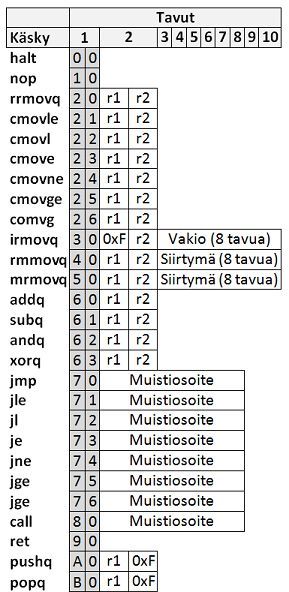y86-64 konekieli¶
Osaamistavoitteet: Käskykanta-arkkitehtuurit ja toteutus y86-suorittimessa.
Suorittimen hardistoteutus perustuu mikroarkkitehtuuriin, joka kuvaa ja toteuttaa suorittimen ohjelmoijalle näkyvän käskykanta-arkkitehtuurin (engl. Instruction set architecture, ISA), josta konekieli on yksi osa. Konekieli on tietokoneohjelman alimman tason laitteistoriippuvainen esitystapa suorittimen äidinkielellä. Konekielen käskyn muodostavat bitit peilautuvat suoraan fyysisten logiikka/mikropiirien sisäisiin portteihin, joiden sisältämän informaation perusteella suoritin toteuttaa käskyt sekvenssilogiikalla.
Edellisessä materiaalissa kävimme läpi y86-64 -assemblykielen käskyt ja tässä kappaleessa esitämme niitä vastaavan käskykanta-arkkitehtuurin ja konekielen toteutuksen.
Käskykanta-arkkitehtuuri¶
Käskykanta-arkkitehtuuri (ISA) siis kuvaa suorittimen toteutuksen niinkuin se ohjelmoijalle näkyy. ISA koostuu seuraavista osa-alueista:
- Tietotyypit mitkä suoritin ymmärtää: ml. 2-komplementtilukuesitys ja liukulukuesitys
- Rekisterit, eli suorittimen sisäinen muisti
- Muistin osoitusmuodot: suora, rekisteri, epäsuora
- Moderneissa suorittimissa erilaisia osoitusmuotoja voi olla jopa kymmeniä!
- Suorittimen tilabitit ja -rekisteri
- Sekvenssilogiikan (ja käyttöjärjestelmän) vaatimat ohjelman suorittamiseen liittyvät tilatiedot: erilaiset virhetilanteet, ym
- Konekielen käskykanta, jossa käskyt jaetaan seuraavasti
- Aritmeettiset operaatiot
- Loogiset operaatiot
- Siirto-operaatiot
- Ohjelman suoritusta ohjaavat käskyt
- Muistin arkkitehtuuri, virtuaalinen muistiavaruus: konekielisten ohjelmien näkemä muisti yhtenäisenä lohkona jossa jokainen muistipaikka koostuu sanoista.
- Muistiosoitteet alkavat (virtuaalisesti) ohjelmalle nollasta, riippumatta siitä missä lohko fyysisesti sijaitsee keskusmuistissa.
- Muistiosoitukset tehdään tällä virtuaalimuistin osoitteella
- Pino, eli ohjelman ajonaikainen tilapäismuisti
- Keskeytysten ja poikkeustilanteiden (oletus)käsittelijät
- Ulkoiset liitynnät: I/O-rekisterit ja -osoiteavaruus
Nyt tietysti sama käskykanta-arkkitehtuuri voidaan toteuttaa erilaisilla mikroarkkitehtuureilla. Esimerkkinä x86- (tai Intelin IA-32- ja Intel64-)käskykanta-arkkitehtuurit, joille on lähes identtisesti yhteensopivat toteutukset eri valmistajien suorittimissa: Intel, AMD, SPARC, jne. Lisäksi eri valmistajat ovat aikojen saatossa laajentaneet käskykantaa omilla suoritinkohtaisilla toteutuksillaan.
y86-konekielen käskyt¶
Konekielen käskyt koostuvat kahdesta osasta:
- Operaatiokoodi (engl. opcode), joka kertoo suoritettavan käskyn tyypin tai käskyryhmän ja sen alifunktion. Yksi tai useampi tavu.
- Operandit : vakioarvo / muisti / rekisteri eri osoitusmuodoissa. Yksi tai useampi tavu.
Assemblykielessä sama jako osiin nähdään selvästi, kun meillä on ihmisen ymmärtämä käskykoodi (=käskyn nimi) ja sille (tässä) maksimissaan kaksi operandia.
rrmovq %rax,%rbx
Operandit¶
Konekielessä voidaan käyttää erilaisia operandeja:
- Vakioarvoja, eli luvut noudattavat erityisesti konekielessä 2-komplementtiesitystä.
- Suoria muistiosoitteita, ovat vastaavasti lukuja.
- Rekisteriosoitusta varten jokaisella rekisterillä on oma numerokoodinsa.
y86-64:sessa rekisterikoodi on nelibittinen (2^4 = 16 rekisteriä), joten yhdellä tavulla kätevästi saadaan esitettyä kaikki suorittimen rekisterit. Tässä erotetaan lähderekisteri (engl. source) ja tulosrekisteri (kohderekisteri, engl. destination). Tässä Numero
0xF tarkoittaa tyhjää operandia, eli rekisteri-operandia ei käskyssä tarvita, esimerkiksi kun operandi on vakioarvo tai muistista haettu arvo.| Rekisteri | Numerokoodi | Rekisteri | Numerokoodi |
| %rax | 0 | %r8 | 8 |
| %rcx | 1 | %r9 | 9 |
| %rdx | 2 | %r10 | A |
| %rbx | 3 | %r11 | B |
| %rsp | 4 | %r12 | C |
| %rbp | 5 | %r13 | D |
| %rsi | 6 | %r14 | E |
| %rdi | 7 | - | F |
Muistiosoitusta varten muistiosoite esitetään vakioarvona, tässä siis 8-tavun (64-bittiä) mittaisena lukuna. (Ja muistetaan se erilainen tavujärjestys.) Käskykoodista riippuen vakioarvo osataan sitten tulkita näissä käskyissä muistiosoitteeksi.
Käskyjen koodaus ja rakenne¶
Näinollen jokaista y86-64 -konekielen käskyä (operaatiokoodi + operandit) vastaa 1-10 tavua seuraavasti.
Käskyn ensimmäinen tavu (1) kertoo käskyn operaatiokoodin, jonka ensimmäinen osa käskytyyppi ja toinen osa käskyn toiminto (funktio).

Hox! Samankaltaisten käskyjen hierarkinen ryhmittely käskykoodin perusteella.
Käskyn seuraavat tavut (2-10) kertovat käskyn operandit.
- Kahden rekisteri-operandin tapauksessa operandien kuvaamiseen riittää yksi tavu:
r1jar2. - Vakiota tai muistiosoitteita käytettäessä tarvitaan lisäksi 8 tavua muistipaikan, muistisiirtymän (engl. offset) tai arvon kuvaamiseen. Tässä tavujärjestys on little endian. Tällöin toinen rekisterioperandi, eli se mitä ei käskyssä tarvita, on merkitty koodilla
F. - Siirtymä (engl. offset) tarkoittaa epäsuorassa muistiosoituksessa mahdollisesti olevaa numeroarvoa, jolla voidaan toteutta suhteellinen muistiosoitus, jossa siis haun muistiosoite on annettu muistiosoite plus/miinus siirtymän arvo.
Esimerkkejä y86-assemblykäskyistä konekielisenä esityksenä.
| Assembly | Konekielen käsky | Selitys |
| cmovg %rax,%rcx | 2601 | cmovg=26, rax=0, rcx=1 |
| irmovq $0x1234,%rsi | 30f63412000000000000 | irmovq=30, F=ei-reg, rsi=6, vakioarvo=1234 |
| addq %rdi,%rax | 6070 | addq=60, rdi=7, rax=0 |
| jne 0x3c | 743c00000000000000 | jne=74, osoite=3c |
| ret | 90 | ret=90 |
| pushq %rbx | a03f | pushq=a0, rbx=3, F=ei-reg |
Mikäli konekielen käskyn operaatiokoodi tai operandit ovat virheellisiä, suoritin asettuu poikkeustilaan (tilalippu) ja aiheuttaa sovitun poikkeuksen
INS. Jos muistiosoitteessa on virhe, aiheutuu siitä taas poikkeus ADR. Nyt kuitenkaan varsinaista poikkeuksien käsittelijämekanismia y86-prosessorissa ei ole, vaan kaikki poikkeukset pysäyttävät sen toiminnan.
Lopuksi¶
Aikoinaan Suomessakin 80-luvun kotimikrobuumin aikana suosituimman Commodore 64-kotimikron suorittimen 6510:n käskykanta löytyy täältä (s. 8-9). Huomataan, että tässä oikeassa prosessorissa oli käytössä vain kolme rekisteriä A (akku), X ja Y! Lisäksi vielä aritmeettisissa operaatioissa rekisterien käyttöön oli jokaiselle rekisterille oma käsky. Myös muistista lukemiseen/kirjoittamiseen löytyy omat käskynsä. Käskykanta on siis vielä alkeellisempi verrattuna y86-prosessoriin.. ja datakirjakin vain 10 sivua vs modernin x86:sen noin 8000 sivua!!
Anna palautetta
Kommentteja materiaalista?